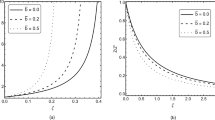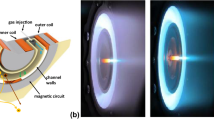Abstract
The concept of the local similarity of nonequilibrium boundary layers in high-enthalpy gas flows past blunt bodies is briefly described. The technical possibilities of the VGU-4 induction high-frequency plasmatron in modeling the aerodynamic heating of the hypothetical Pre-X (CNES) spacecraft in the vicinity of the stagnation point of a high-enthalpy air flow are presented. The engineering approach to quantitatively reproduce the thermochemical effect of a dissociated air flow on the vehicle surface in the high-heat region of the terrestrial entry trajectory is developed. In this approach the full-scale values of the total enthalpy, the stagnation pressure, and the velocity gradient at the stagnation point near the surface are reproduced in the experiment. The effective coefficients of O and N atom recombination on a silicone carbide (SiC) surface are determined under the conditions similar with those of the peak heating of the Pre-X vehicle surface in the vicinity of the flow stagnation point.
Similar content being viewed by others
References
A. Kolesnikov, “The Aerothermodynamic Simulation in Sub-and Supersonic High-Enthalpy Jets: Experiment and Theory,” in: Proc. 2nd European Symposium on Aerothermodynamics for Space Vehicles. ESA SP-367, 1995 (1995), p. 583.
A.N. Gordeev and A.F. Kolesnikov, “High-Frequency Induction Plasmatrons of the VGU Series,” in: Topical Problems inMechanics. Physico-ChemicalMechanics of Liquids and Gases [in Russian], Nauka,Moscow(2010), p. 151.
P.N. Baronets, A.N. Gordeev, A.F. Kolesnikov, V.M. Mysova, I.S. Pershin, V.N. Prilepskii, Yu.K. Rulev, A.S. Trukhanov, and M.I. Yakushin, “Testing of Thermal-ProtectiveMaterials for the Buran Orbiter on Induction Plasmatrons,” in: Gagarin Scientific Readings on Cosmonauticsand Aviation, [in Russian], Nauka, Moscow (1991), p. 41.
A.N. Gordeev, A.F. Kolesnikov, and M.I. Yakushin, “An Induction Plasmatron Application to ‘Buran’s’ Heat Protection Tiles Ground Tests,” J. SAMPE 28(3), 29 (1992).
A.F. Kolesnikov, I.S. Pershin, S.A. Vasil’evskii, and M.I. Yakushin, “Study of Quartz Surface Catalycity in Dissociated Carbon Dioxide Subsonic Flows,” J. Spacecraft and Rockets 37, 573 (2000).
A.F. Kolesnikov, A.N. Gordeev, and S.A. Vasil’evskii, “Effects of Catalytic Recombination on Metal and Quartz Surfaces under the Conditions of the Entry into the Martian Atmosphere,” High Temperature 54 (1), 29 (2016).
A.F. Kolesnikov and M.I. Yakushin, “Determination of the Effective Probabilities of the Heterogeneous Atom Recombination from the Heat Fluxes to a Surface in a Dissociated-Air Flow,” Mat. Model. 1 (3), 44 (1989).
S.A. Vasil’evskii, A.F. Kolesnikov, and M.I. Yakushin, “Determination of the Effective Probabilities of Heterogeneous Atom Recombination under the Conditions of Gas-Phase Reaction Influence on Heat Fluxes,” High Temperature, 29 (3), 411 (1991).
P.N. Baronets, A.F. Kolesnikov, S.N. Kubarev, I.S. Pershin, A.S. Trukhanov, and M.I. Yakushin, “Overequilibrium Heating of the Surface of a Heat-Shield Tile in a Subsonic Jet of Dissociated Air,” Fluid Dynamics 26 (3), 437 (1991).
S.A. Vasil’evskii, A.F. Kolesnikov, and M.I. Yakushin, “Mathematical Models for Plasma and Gas Flows in Induction Plasmatrons,” Molecular Physics and Hypersonic Flows 482, 495 (1996).
N.G. Bykova, S.A. Vasil’evskii, A.N. Gordeev, A.F. Kolesnikov, I.S. Pershin, and M.I. Yakushin, “Determination of the Effective Probabilities of Catalytic Reactions of the Surfaces of Heat Shield Materials in Dissociated Carbon Dioxide Flows,” Fluid Dynamics 32 (6), 876 (1997).
A. Kolesnikov, M. Yakushin, S. Vasil’evskii, I. Pershin, and A. Gordeev, “Catalysis Heat Effects on Quartz Surfaces in High-Enthalpy Subsonic Oxygen and Carbon Dioxide Flows,” in: Proc. 3rd Europ. Symp. on Aerothermodynamics for Space Vehicles, ESTEC, Noordwijk, The Netherlands. 1999 (1999), p. 537.
A.F. Kolesnikov, I.S. Pershin, and S.A. Vasil’evskii, “Predicting Catalycity of Si-Based Coating and Stagnation Point Heat Transfer in High-Enthalpy CO2 Subsonic Flows for the Mars Entry Conditions,” in: Proc. Int. Workshop ‘Planetary Probe Atmospheric Entry and Descent Trajectory Analysis and Science’, Lisbon, Portugal, 2004 (2004), p. 77.
A.F. Kolesnikov, A.N. Gordeev, and S.A. Vasil’evskii, “Heat Transfer in Sub-and Supersonic Nonequilibrium Jets of Carbon Dioxide Plasmas,” in: Proc. 7th Eur. Symposium on Aerothermodynamics ESA SP-69. ESA Communications, ESTEC, Noordwijk, The Netherlands, 2011 (2011).
A.F. Kolesnikov, “Conditions of Simulation of Stagnation Point Heat Transfer from a High-Enthalpy Flow,” Fluid Dynamics 28 (1), 131 (1993).
A.F. Kolesnikov, “The Concept of Local Simulation for Stagnation Point Heat Transfer in Hypersonic Flows: Application and Validation,” AIAA Paper No. 2515 (2000).
A.F. Kolesnikov, “Conditions of the Local Modeling of the Thermochemical Interaction between High-Enthalpy Gas Flows and Indestructible Surfaces,” High Temperature, 52 (1), 110 (2014).
J.-L. Vérant, N. Perron, M. Balat-Pichelin, O. Chazot, A. Kolesnikov, V. Sakharov, O. Gerasimova, and P. Omaly, “Microscopic and Macroscopic Analysis for TPS SiC Material under Earth andMars Re-entry Conditions,” Int. J. Aerodynamics 2 (2/3/4), 152 (2012).
A.F. Kolesnikov and V.S. Shchelin, “Numerical Analysis of Simulation Accuracy for Hypersonic Heat Transfer in Subsonic Jets of Dissociated Nitrogen,” Fluid Dynamics 25 (2), 278 (1990).
P.F. Barbante and O. Chazot, “Flight Extrapolation of PlasmaWind Tunnel Stagnation Region Flowfield,” J. Thermophys. Heat Transfer 20, 493 (2006).
V.V. Lunev, Real Gas Flows with High Velocities, CRC Press (2009).
Author information
Authors and Affiliations
Corresponding author
Additional information
Original Russian Text © S.A. Vasil’evskii, A.N. Gordeev, A.F. Kolesnikov, 2017, published in Izvestiya Rossiiskoi Akademii Nauk, Mekhanika Zhidkosti i Gaza, 2017, Vol. 52, No. 1, pp. 160–167.
Rights and permissions
About this article
Cite this article
Vasil’evskii, S.A., Gordeev, A.N. & Kolesnikov, A.F. Local modeling of the aerodynamic heating of the blunt body surface in subsonic high-enthalpy air flow. Theory and experiment on a high-frequency plasmatron. Fluid Dyn 52, 158–164 (2017). https://doi.org/10.1134/S001546281701015X
Received:
Published:
Issue Date:
DOI: https://doi.org/10.1134/S001546281701015X




